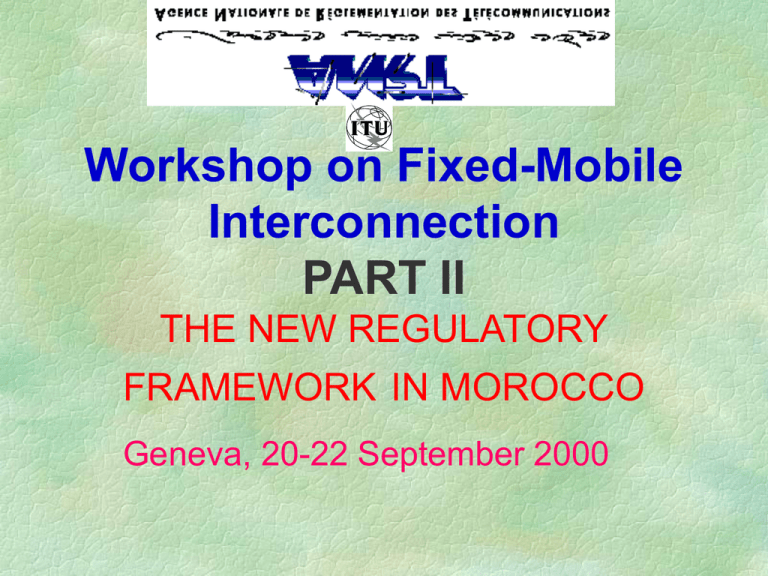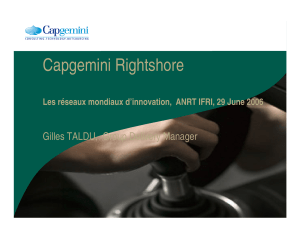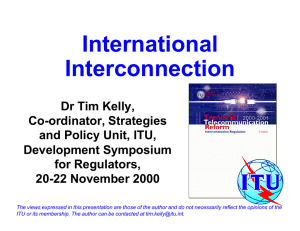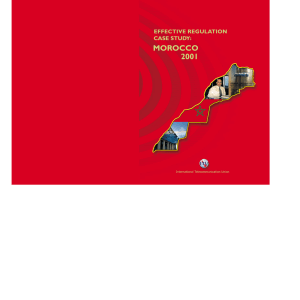Workshop on Fixed-Mobile Interconnection PART II THE NEW REGULATORY
advertisement

Workshop on Fixed-Mobile Interconnection PART II THE NEW REGULATORY FRAMEWORK IN MOROCCO Geneva, 20-22 September 2000 Map of Morocco Some Facts Population (millions) 28 to 30 Area (sq. Km) 710,850 GDP per capita ($) 1260 Inflation rate (April 2000) 2,2% Language : Arabic, Berbers, business conducted in French, English and Spanish Some Facts (cont.) Largest phosphate reserves in the world Diverse agricultural (including aquaculture) sector Oil and gas recently discovered Large tourism industry Growing manufacturing sector Considerable inflows of funds from Moroccans working abroad Growing foreign direct investments The telecommunications sector context New telecommunications law (law 24-96) One state-owned operator (Maroc Telecom) • Fixed Line Services : 1,5 million subscribers • Teledensity : 5% • Wireless Services : 6000 subscribers for NMT and over 400,000 subscribers for GSM (over 250 000 prepaid cards) • The Second GSM private Operator (Medi Telecom) • Two GMPCS Operators • ORBCOMM Maghreb (positioning; messaging) • TESAM Maroc (all services) • Three VSAT Operators (SpaceCom, Gulfsat Maghreb, Argos) Before the 24-96 law Creation of the National Post and Telecommunication Office (ONPT) in 1984 ONPT started associating the private sector in network building “civil engineering works connections and cable laying”, 1988 In 1989, the private sector was authorized to set up and commercialize terminal equipment. In 1992 ONPT launched the public phone project by associating the private sector in managing the public phones. For the internet, ONPT has authorized in 1995 the internet service providers to offer Internet services by using its fixed network. The 24-96 Law After 73 years of the state owned monopoly domination, it was decided in August 1997 to completely liberalize the Telecom sector. The incumbent became a corporation and its privatization is currently under way. A mobile phone license was issued for the profit of MEDITELECOM in order to operate a second GSM Network. 2 GMPCS licenses were issued. 3 VSAT licenses were issued. The main objective of issuing the second GSM license was to introduce progressively competition in the Telecom Market as it is stated in the 24-96 Law. The 24-96 Law • Open competition to all telecommunication activities • Does not impose the time limits for opening market segments to competition • Liberalize price except for those related to the Universal Service and interconnection • Set up a financial contribution required by all operators for the benefit of the Universal Service, land management, R&D and training. The 24-96 Law aims at : Create an efficient and transparent regulatory framework. Enhance the telecom Network and keep up with technology progress in the era of an open Telecom Market. Fulfill the universal service mission. Contribute via the telecom sector to the development of national economy. The 24-96 Law aims at : Separate between telecommunication and post activities Separate between regulatory matters and operational issues Create a regulatory organization (ANRT) for the Telecom sector. National Telecommunication Regulatory Agency (ANRT) A Prime Minister Public Agency. Prepare studies and regulatory acts for the Telecom sector. Ensure the strict application of the rules. Financially autonomous body. ANRT ATTRIBUTIONS Missions Past Now Frequency spectrum management Minstère des Postes et Télécommunications ANRT Preparations of regulatory acts Minstère des Postes et Télécommunications ANRT Office National des Postes et Télécommunication ANRT equipment approval Tenders preparation for license issuing Tariff proposition ANRT Office National des Postes et Télécommunication ANRT Interconnection dispute settlement ANRT Cryptography control ANRT The Regularly Framework 1. License regime Public Network using the public phone domain Public Network using the radio spectrum 2. Authorization regime Private Networks 3. Agreement regime Radio electric settlement Terminal equipment Test and monitoring laboratory 4. Declaration Regime Value added services 5. Regime of free settlement Internal Networks Low power radio The Interconnection decree • Define the obligations of competitive operators • Define the role of ANRT as regulator OPERATORS ’OBLIGATIONS Respect principles and rules of interconnection. Produce all necessary information to the regulator. Operators who hold a market share higher than 20% of a telecommunications service must submit an interconnection offer to the regulator for approval. Also they shall inform the regulator regularly of the modifications concerning the interconnection offers. THE ROLE OF ANRT Ensure clear terms, conditions and fair prices for interconnection Make sure that the interconnect agreement is in accordance with the interconnection decree and approve the interconnection offer Impose sanctions and penalties for violation of regulation Play a role of arbitrator in the interconnect dispute ANRT AS ARBITRATOR REFERALL TO THE ANRT How? When? Inquiry of the dispute file made 30 days by the Director of the ANRT No conclusion of the interconnect agreement Post-agreement disputes Decision of the (administrative committee) 15 days SOME SIGNIFICANT GSM FIGURES IAM GSM subscribers MEDITEL GSM subscribers MÉDITEL service 1000000 launch 900000 800000 700000 600000 500000 400000 Appel à expression d’intérêt Licence process launch IAM Prepaid cards launch License awarding to MEDITEL 300000 200000 100000 0 1994 1995 1996 1997 1998mar- jun- sept- jan- mar- may- jun99 99 99 00 00 00 00 CONCLUSION 1- The deregulation of telecommunication in Morocco progresses in time and space. 2- Th new reforms opened widely Morocco to competition in the telecommunications sector. 3- Moroccan Customers and the economy of the kingdom benefit from the new reforms of the sector. 4- Deregulation does not mean absence of rules. 5- A minimum intervention is necessary whenever it is required using coordination and arbitrage.




